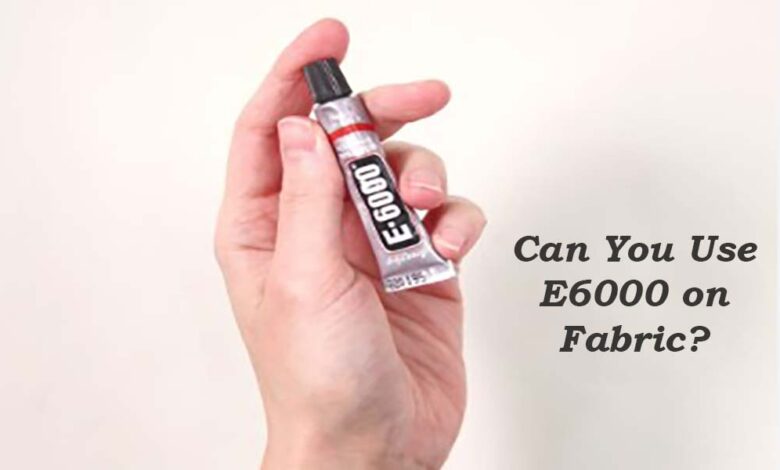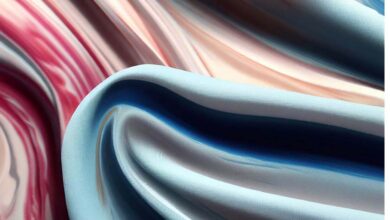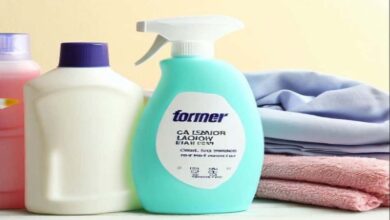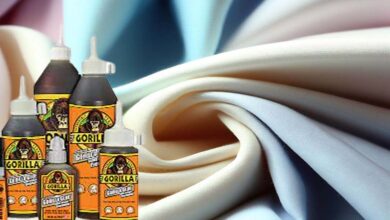Can You Use E6000 on Fabric? The Truth Unveiled

Can you use E6000 on fabric? Yes, e6000 can be used on fabric as it is a versatile adhesive that bonds well to various materials, including fabric. It provides a robust and flexible hold, making it suitable for a wide range of fabric projects.
Just make sure to apply a thin, even layer of e6000 on the fabric and allow it to dry entirely before bonding the fabric to other surfaces or objects. Remember to follow the manufacturer’s instructions and test the adhesive on a small, inconspicuous area of the fabric before applying it to the entire piece.
What Is E6000 And Its Key Characteristics?
E6000 is a versatile adhesive that can be used on fabric and various other surfaces. Its strong bonding power ensures a secure hold, while its flexibility and durability make it perfect for fabrics that require movement. This adhesive is also resistant to weather and temperature changes, making it suitable for indoor and outdoor applications.
Whether you’re working on a craft project or repairing a fabric item, e6000 is a reliable choice. Its ability to adhere to multiple surfaces and withstand various conditions makes it a popular adhesive in the crafting and DIY community.
Can You Use E6000 On Fabric?

If you’re wondering if you can use e6000 on fabric, the answer is a definite yes. It’s a dependable option for your fabric-related projects. E6000 is a popular adhesive known for its versatility and strength. Many crafters wonder if it is suitable for use on fabric.
Here, we will explore the effectiveness of using e6000 on fabric and some factors to consider before doing so.
Factors To Consider Before Using E6000 On Fabric:
Before using E6000 on fabric, several important factors must be considered to ensure a successful and long-lasting bond. Here are some key considerations:
Fabric type:
E6000 is commonly used on hard surfaces such as metal, glass, and wood. However, it can also be used on certain types of fabric. Before applying e6000 to fabric, consider the type and texture of the material. Smooth, non-porous fabrics tend to work better with this adhesive.
Washability:
If you plan on using e6000 on fabric that must withstand washing, it is essential to test its washability. While e6000 is generally known for its durability, it may not hold well under repeated washing or exposure to specific cleaning agents. Consider this before using it on fabric items requiring frequent laundering.
Drying time:
E6000 has a relatively long drying time, often taking 24 to 72 hours to cure fully. This can be a consideration when using it on fabric, as you’ll need to ensure the fabric remains undisturbed during this drying period. Plan your application accordingly and allow sufficient drying time before handling or using the fabric.
Adhesion strength:
While e6000 provides a strong bond, assessing the adhesion strength needed for your fabric project is vital. Consider the weight and strain the fabric will endure and any flexibility required. E6000 may work best for projects that do not require significant flexibility or stretch.
Testing on a small fabric swatch:
Before using e6000 on your fabric project, conducting a small test on a fabric swatch is highly recommended. Apply a small amount of e6000 to the fabric and allow it to dry completely. Test the adhesion by gently pulling and stretching the fabric. This will help determine if the bond is strong enough for your intended use.
Overall, while e6000 can be used on fabric, it is crucial to consider the factors mentioned above before application. Testing the adhesive on a small fabric swatch is pivotal to ensuring your project’s suitability. The e6000 can be a valuable tool for bonding fabric to various surfaces with proper preparation and evaluation.
Does e6000 Work On Fabric?
Yes, E6000 is a versatile adhesive that works well on fabric. It is commonly used to bond various materials, including fabric, leather, wood, metal, and glass. When applied correctly, E6000 creates a strong and flexible bond on fabric, making it suitable for various fabric projects. For know more details, watch the video.
Tips And Techniques For Using E6000 On Fabric
Using e6000 on fabric requires proper surface preparation for optimal adhesive performance. Before applying the adhesive, ensure the fabric is clean and free from dirt, dust, or oils. This can be achieved by washing the fabric and letting it dry completely.
When applying e6000 on fabric, following the dos and don’ts is essential. Do apply a thin, even layer of adhesive to the fabric, avoiding excessive amounts that could soak through. Don’t apply the adhesive too close to the fabric’s edges to prevent it from seeping out.
Once applied, allow the e6000 adhesive to dry and cure for the recommended timeframes. This will ensure a solid and durable bond. Proper drying times vary depending on factors such as temperature and humidity. It is advisable to refer to the product instructions for specific guidance.
Following these guidelines, you can effectively use e6000 on fabric, creating secure and long-lasting bonds for your projects.
Pros And Cons Of Using E6000 On Fabric
Using the right adhesive is crucial when working on fabric projects. One popular adhesive among crafters and DIY enthusiasts is e6000. But can you use e6000 on fabric?
Let’s explore the pros and cons of using this adhesive for fabric projects.
Advantages Of Using E6000 Adhesive For Fabric Projects:
- Versatility: E6000 is a multi-purpose adhesive that can bond various materials, including fabric, metal, glass, and more. This makes it a great choice when working on projects that involve fabric and other materials.
- Strong bond: When properly applied, e6000 forms a solid and durable bond on the fabric. It creates a flexible bond that can withstand stress and movement, making it ideal for projects requiring stretched or manipulated fabric.
- Waterproof: E6000 is water-resistant, making it suitable for fabric projects that may come into contact with moisture. You can confidently use it for projects like creating outdoor cushions or fixing water-damaged fabric items.
Potential Disadvantages And Considerations When Using E6000 On Fabric:
- Strong odor: E6000 has a strong odor due to its chemical composition. This can be a downside for individuals sensitive to strong smells or those working in poorly ventilated areas. Using this adhesive in a well-ventilated space or using it outdoors is advisable.
- Long curing time: E6000 requires adequate curing time to achieve maximum strength. Depending on the project and environmental conditions, it typically takes 24 to 72 hours to cure fully. This means you’ll need to plan your project and allow sufficient time for the adhesive to set before using or handling the fabric.
- Some discoloration potential: While e6000 dries clear, certain fabrics may show some degree of discoloration when the adhesive is applied. It’s always a good idea to test the adhesive on a small, inconspicuous area of the fabric before applying it to the entire project.
So, if you’re considering using e6000 adhesive on fabric for your next project, remember its advantages, such as versatility, a strong bond, and waterproof properties. However, be mindful of potential downsides, including the strong odor, long curing time, and the possibility of fabric discoloration.
Potential Issues And Precautions With E6000 On Fabric
E6000 is a popular adhesive for various crafts and DIY projects. It offers a strong bond and is known for its versatility. However, when it comes to using e6000 on fabric, there are certainly potential issues to be aware of.
It is vital to take precautions to ensure successful fabric adhesion and avoid mishaps. Let’s delve into some of the possible issues and the precautions you should take:
Possible Issues That May Arise When Using E6000 On Fabric
- Staining: E6000 adhesive can leave behind dark marks or stains on certain types of fabrics. This issue is more familiar with light-colored or delicate fabrics. It is essential to test the adhesive on a small, inconspicuous area of the fabric before applying it to the entire surface. This will help you determine if there will be any staining or discoloration.
- Bond failure: While e6000 is a strong adhesive, bond failure is possible when used on certain fabrics. This can occur if the adhesive is not applied evenly or the fabric has a special coating that prevents proper adhesion. It is essential to follow the manufacturer’s instructions for application and ensure the fabric is clean and free from any residues or oils that may hinder bonding.
- Flexibility: Fabric is often subject to movement, and bending is mainly used in clothing or accessories. One potential issue with using e6000 on fabric is that it may not retain flexibility after drying, resulting in a stiff or uncomfortable feel. Applying the adhesive sparingly and avoiding over-application is crucial, allowing the fabric to maintain its natural flexibility.
Precautions To Take To Ensure Successful Fabric Adhesion
- Test and wait: Before applying e6000 adhesive to your fabric, it is crucial to perform a patch test. Apply a small adhesive to an inconspicuous area and allow it to dry completely. Check for any staining, discoloration, or bond failure. Waiting for at least 24 hours will give you a better idea of the adhesive’s impact on the fabric.
- Clean and dry: To ensure proper adhesion, cleaning the fabric thoroughly before applying e6000 is essential. Remove dirt, dust, or oils using a fabric-safe cleaner. Allow the fabric to dry completely before applying the adhesive to ensure a strong bond.
- Apply sparingly: Less is more when using e6000 on fabric. Apply the adhesive sparingly to avoid excess seepage and staining. A thin, even layer is all you need for a secure bond. Applying too much adhesive can lead to stiffness or discomfort.
- Follow drying time: E6000 requires a specific drying time to achieve maximum bond strength. Different fabrics may require different drying durations. Follow the manufacturer’s instructions and allow the adhesive ample time to dry before subjecting the fabric to any stress or movement.
Using e6000 on fabric can yield impressive results when the proper precautions are taken. By being mindful of the potential issues and adhering to the recommended precautions, you can ensure successful fabric adhesion and create beautiful and durable projects. Remember to test, clean, apply sparingly, and allow sufficient drying time to achieve the best results with e6000 on fabric.
So go ahead, get creative, and let your imagination soar!
Tips For Proper Care And Maintenance Of Fabric Projects Using E6000
E6000 is a popular adhesive used for fabric projects and various other applications. Proper care and maintenance of fabric projects using E6000 can extend their lifespan and ensure they stay in good condition. Here are some tips to help you achieve that:
Read the Instructions:
Always follow the manufacturer’s instructions for the E6000 adhesive. Different projects may have specific requirements, and the instructions will provide essential information on application and curing times.
Surface Preparation:
Clean and prepare the fabric surface before applying the adhesive. Ensure it is free from dust, dirt, oil, and other contaminants that could hinder the bond.
Ventilation:
When using E6000, make sure you are in a well-ventilated area. The fumes can be strong, so open windows or work outside if possible. Consider wearing a mask to protect yourself.
Use in Thin Layers:
Apply the E6000 adhesive in thin layers for better adhesion. Too much adhesive can create a mess and weaken the bond.
Clamping or Weighing Down:
Depending on the project, you may need to clamp or weigh down the fabric pieces after applying the adhesive. This ensures proper contact and prevents the pieces from shifting while the adhesive cures.
Curing Time:
E6000 adhesive typically takes 24 to 72 hours to cure fully. Avoid putting stress on the bonded area until it has completely cured.
Temperature Considerations:
E6000 is sensitive to temperature. For optimal results, it is best to apply the adhesive at room temperature (around 70°F or 21°C).
Washing Instructions:
If the fabric project is washable, ensure you know the washing instructions for the fabric type. Hand washing or delicate cycles are sometimes recommended to prolong the bond.
Avoid Extreme Conditions:
While E6000 is known for its versatility, it may not perform well under extreme conditions, such as prolonged exposure to direct sunlight or extreme heat.
Storage:
Properly close the E6000 adhesive container and store it in a cool, dry place to extend its shelf life and maintain its effectiveness.
Test Before Use:
Before applying E6000 to your fabric project, it’s a good idea to test the adhesive on a small, inconspicuous area of the fabric to ensure compatibility and check the bond strength.
Handle with Care:
Treat fabric projects with E6000 carefully, especially if they have delicate embellishments or decorative elements attached. Avoid tugging or pulling on glued areas.
By following these tips, you can enhance the durability and longevity of your fabric projects using E6000 adhesive. Always prioritize safety, proper application, and adhering to the manufacturer’s guidelines to achieve the best results.
FAQ
Is E6000 Safe For Fabric?
E6000 is generally safe for fabric when used as directed. However, it is recommended to test the adhesive on a small, inconspicuous area of the fabric before applying it to the entire surface. This helps ensure compatibility and prevents any damage or discoloration.
Is E6000 Permanent On Fabric?
Yes, e6000 is permanent on fabric once it is fully cured. It forms a strong bond with the fabric fibers, providing long-lasting adhesion. However, keep in mind that proper application and drying time are essential to ensure the best results.
Is E6000 Adhesive Washable On Fabric?
Yes, e6000 adhesive can be used for bonding different fabric types. Whether you are working with cotton, silk, denim, or polyester, e6000 provides a strong and durable bond. It is vital to ensure the fabric surfaces are clean and free from any oils or residues before applying the adhesive for optimal results.
Is E6000 Toxic?
E6000 is considered toxic, but it’s essential to understand that it is only harmful if ingested or used in an improperly ventilated area. When using e6000, working in a well-ventilated space or using a respirator to prevent inhalation of the fumes is recommended.
Avoid contact with skin and eyes, as the adhesive can cause irritation or allergic reactions. If contact occurs, wash the affected area thoroughly with soap and water. Keep e6000 out of reach of children and pets to prevent accidental ingestion.
Sum Up
After exploring the topic on can you use e6000 on fabric, it is evident that this adhesive can be a versatile option for various fabric-related projects. With its strong bond and flexibility, the e6000 offers a reliable solution for attaching rhinestones and embellishments and even repairing tears and seams.
However, it is crucial to consider the type of fabric being used and the application method. It is recommended to perform a patch test on a small, inconspicuous area of the fabric before applying e6000 to ensure compatibility. Additionally, proper ventilation is essential when working with this adhesive due to its strong odor.
Remember to follow the manufacturer’s instructions and safety precautions when using e6000. If used correctly, e6000 can be a valuable tool in your fabric crafting arsenal, providing a durable and long-lasting bond for your creations.



